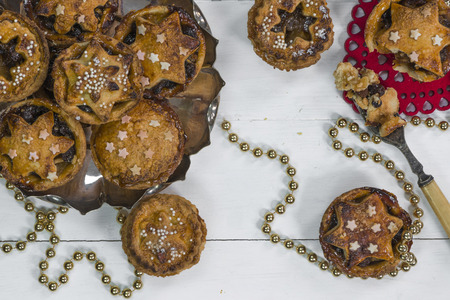
As a child, I often wondered why my grandmother’s minced beef issuing forth from the grinder, wasn’t to be found in any of the mince pies we had for Christmas.
I stopped looking after the age of eight ! It is the case that back in the Middle Ages, meat especially lamb and also some pork was the key ingredient of any self-respecting pie. If you could afford beef all the better, if you couldn’t offal or perhaps a fowl such as duck or goose. To bring out the flavour, a variety of fruits, spices and other flavoursome ingredients were added such as suet which helps form an emulsion, then all was encased in a pastry covering and baked – hence the mince pie.

I still leave a mince pie out for Santa Claus on Christmas Eve and it is eaten when I come down in the morning. Given we only have a cat, what’s the story behind that ?
Well, how did the fruit combination with meat come about ? It appears that Crusaders returning home from the wars of the Holy Land and onwards to Jerusalem brought a number of innovations with them. The idea of adding fruit or honey anyway to meat is very much the basis of creating exciting tagines and Middle Eastern cookery generally so we realise the potency of such flavour. From 1100 onwards, adding spices not found in Northern Europe such as sage and rosemary – a rare commodity anyway at the time was also established as a new method to preserve meat or at least disguise its noisome flavour when it went rancid. The spices we find nowadays are always mixed, but nutmeg, clove and some cinnamon are commonplace. The remainder of the filling is always and predominantly sultanas and candy-peel with perhaps the odd glace cherry, pieces of apple and nuts.
The earliest mince pies, not a name in vogue back then in sword-fighting times were also called Christmas pies, shred or shred pies and mutton pie. There is no evidence to back-up this idea but they were said to be specifically oval pies in shape and not round as they are now. The oval shape was claimed to resemble the manger in the Nativity scene, with a covering of pastry to resemble the swaddling cloths covering the baby Jesus. A star for a topping was also an established image to represent that celestial body followed by the Three Wise Men. These pies have hence been associated with Christmas and it is customary to eat at least one pie for every day of the 12 days of Christmas so as to bring daily good luck. Don’t refuse one – it’s bad luck ! Stir the mincemeat in a clockwise direction too as the other way is bad luck too. Don’t cut a mince pie with a knife and make a wish if it’s your first. Incidentally, three spices are used to symbolise the gifts of the Magi. Clearly, religious and probably pagan reminders in our food reinforced the Christmas message at whatever level and still do.
The mince pie became a status symbol with the accession of the Stuarts in the early 1600s. It was only from the middle of the 1800s that the idea of adding meat gradually disappeared but the name ‘mince’ was retained. The pie began to exploit fruit, dried in particular, most nuts, the spices and new ideas in baking pastry to create a round case of a more accessible size and the oval was lost. From a food technologist’s viewpoint, mincemeat is often made up to 2 months before hand when the leaves on the trees are starting to drop, and stored in a sealed jar to allow all the flavours to enmesh. It certainly has an appreciated shelf-life !
We might have lost the mince pie and even Christmas altogether if the Puritans had held sway in the mid to late 1600s. Christmas including our frivolous mince pie was banned following Cromwell’s parliament. However the Reformation meant Christmas was restored as were the traditions that accompanied it. In Georgian times, from the 1700s onwards, wealth could be displayed with a humble pie. Mince pies were turned into extravagant shapes such as stars or flowers. These could also be fitted into puzzles such as ‘knot gardens’ or displayed in tiers.
And so we celebrate the mince pie. There are some great blog sites which also cover, far more expertly I might say the humble pie (mine included) but I hope to add further gobbets as I explore this popular treat
There are some excellent web-sites with recipes for mince pies. Check out the version by Delia Smith, Director of that great football club Norwich City.
The Mince Pie Recipe
Serves: 12 preparation time is 1 hour. It usually takes 20 minutes to cook and should be ready in an hour and twenty minutes.
[Please note we are an affiliate marketing partner and will make a sales commission if you purchase any items through our affiliate links. Please read our affiliate disclosure] .
To make mince pies, you’ll need the following equipment:
Essential Equipment:
- Mixing Bowl(s): For preparing the pastry and possibly the mincemeat if homemade.
- Rolling Pin: To roll out the pastry dough evenly.
- 12-Cup Muffin Tin or Shallow Mince Pie/Tart Tin: To shape and bake the pies.
- Cookie Cutter(s): A round cutter for the pastry bases (slightly larger than the tin openings) and a smaller one (or decorative shapes) for the pastry lids.
- Pastry Brush: For brushing the tops of the pies with egg wash or milk for a golden finish.
- Knife: For trimming excess pastry or making decorative cuts.
- Spoon: To scoop the mincemeat filling into the pastry cases.
- Cooling Rack: To allow the pies to cool properly after baking.
Optional Equipment:
- Food Processor: To quickly combine ingredients for the pastry.
- Zester or Grater: If you want to add zest to the pastry or filling.
- Piping Bag: For adding decorative touches, like icing, after baking.
- Pastry Crimper or Fork: To seal edges and create patterns on the lids.
Ingredients:
- 330g to 350g (11 or 12 oz) high-quality mincemeat
- 225g (8 oz) plain flour
- 2 tablespoons caster sugar
- 125g (4½ oz) unsalted butter, cubed/diced
- 1 large egg, beaten but not whipped
- milk for glazing which means a pastry brush is needed here.
Preparation:
- Lightly butter a 12-case pie tray or a patty tin if you know what one is.
- Add the mincemeat to a bowl and stir so that the whole mixture is able to be spread out and is evenly distributed.
- Place the flour, sugar and butter in a food processor and process briefly until resembling breadcrumbs. Add the egg through the feeder tube but slowly, of so slowly. Alternatively, rub the butter into the dry ingredients by hand and stir in the egg.
- Bring the mixture together and mold it with your hands. Wrap in cling film and chill for an hour.
- Thinly roll out the pastry onto a floured surface. Cut out 12 circles with a fluted pastry cutter, large enough to fill the cases in the pie tin. Press gently into each case, then fill evenly with the mincemeat.
- Cut out another 12 slightly smaller circles and use to cover the mincemeat. Press the edges together with the end of a fork to seal. Make a small slit in the top of each, then brush lightly with milk. Chill for about 30 minutes.
- While chilling, preheat the oven to 200°C / Gas Mark 6.
- Bake the pies for 20 minutes until golden brown but not burnt.
- Check for seepage as these are notorious for mincemeat oozing between the lid and the pastry case. Cool on a wire rack and serve warm.
Products
Please note this page contains links to our affiliate marketing partners. Please read our affiliate disclosure.

It is that time again. I still buy them in but have given these a whirl.